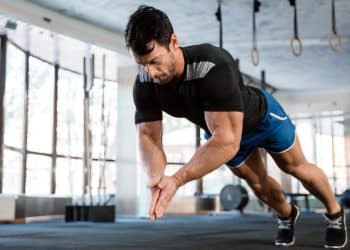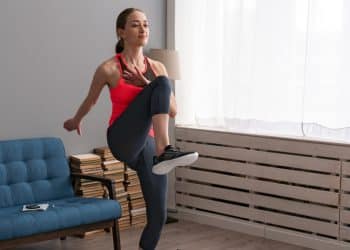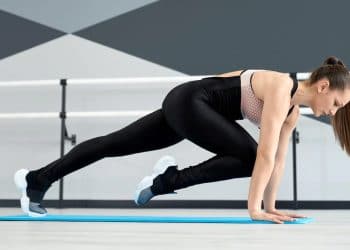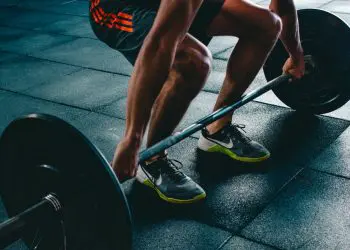You don’t need to be a mountaineer to benefit from vertical mountain climbers. A little coordination and hip/shoulder mobility is all that’s required to do this beginner-friendly bodyweight cardio activity. Similar to jumping rope or doing box jumps, you’ll get a leg and butt workout while shredding through calories.
A jack of all trades, you can use vertical mountain climbers as a pre-training warmup, fitness class exercise, hotel fat burner, or finisher at the end of a grueling training session.
All it takes is a few minutes to learn the movement and you’ll have a functional, explosive cardio activity, with no equipment or training tools necessary!
Muscles Worked During Vertical Mountain Climbers
While it’s not a “muscle-building activity”, vertical mountain climbers do involve the lower body and core muscles. We’d liken it more to a muscle conditioning exercise for your glutes, quads, hamstrings, and calves while keeping the abs healthy and promoting mobility and range of motion.
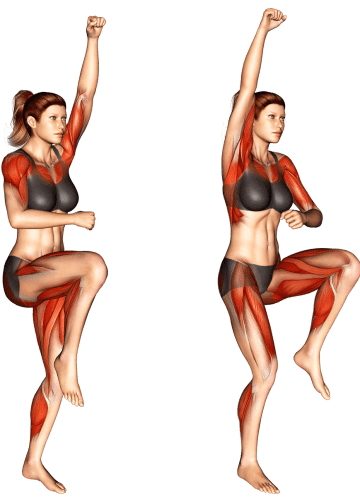
In this section, you’ll get a short lesson on the anatomy and function of the primary muscles involved in vertical mountain climbers.
Core
Your abdominals, obliques, and even lower back should be engaged and strong during vertical mountain climbers. Not because it’s a dangerous exercise for the lower back, but it’s always good practice.
Level Up Your Fitness: Join our 💪 strong community in Fitness Volt Newsletter. Get daily inspiration, expert-backed workouts, nutrition tips, the latest in strength sports, and the support you need to reach your goals. Subscribe for free!
The abdominals, and especially deeper core muscles are important for efficient energy transfer, proper exercise posture, and overall strength of other muscle groups.
Hip flexors
The hips/flexor muscles make up a large portion of the lower body. In fact, the gluteus maximus (butt) is said to be the largest of all muscles in the human physique. But let’s talk about the hip flexors, that are highly active during vertical mountain climbers.
Five hip flexors include:
- Iliacus
- Psoas (major and minor)
- Rectus femoris
- Iliocapsularis
- Sartorius
Of the five hip flexors, psoas (pronounced so-as) gets the most attention and rightly so. It’s the largest, and strongest hip flexor that helps connect your spine to your legs along with other muscles in the lower body. Psoas contributes to posture by acting on the lumbar vertebrae, and together with iliacus forms the iliopsoas that helps lift the knee up past 90 degrees.
Leg muscles
Vertical mountain climbers are a good way to keep your body coordinated, and functional, and the lower body has a lot to do with it. The glutes, hamstrings, quads and calf muscles bend and extend our joints, help us to walk, jump, and move in many different ways.
Quadriceps – The quads are a group of five muscles on the front part of the upper leg that cross both the knee and hip joint. Their job is to flex the hip when you dip down into a squat, and extend the knee as you stand up. The same action occurs to a lesser degree during vertical mountain climbers.
Hamstrings – Located opposite the quads on the backside of the upper leg, hamstrings also perform the opposite function – flex the knee when you dip down into a squat, and extend the hip during the concentric phase of the rep. There are only three hamstring muscles, unlike the quads that have five!
Glutes – The gluteal or butt muscles, especially the gluteus maximus form most of the buttocks and hips shape and size. A larger and powerful muscle, your butt helps to extend the thigh, like when you perform a jump or explosive athletic movement.
Calves – Lastly, calves are the lower leg muscles (larger gastrocnemius and smaller soleus) that bend the foot down (plantarflexion), and contribute to running and jumping activities.
Benefits of Vertical Mountain Climbers
There are more benefits to vertical mountain climbers than meets the eye. So don’t turn your nose up so quickly. Here are the most notable benefits you can expect from this bodyweight activity.
Build your heart muscles and burn calories
It’s estimated that more than 60 percent of U.S. adults do not meet the minimum recommendation for physical activity, and 25 percent don’t exercise at all (1). And technology may only make this worse.
Healthy lifestyle habits like regular exercise help us to live longer, stave off diseases, and feel and look better. However, there are many obstacles to getting people to be more active. But perhaps a simple activity, like vertical mountain climbers, are less intimidating, and a great option to break the barrier to exercise. They’re easy to learn, involve many muscles, get your heart rate up, and don’t require a gym membership.
Good for balance and coordination
Lack of activity also makes us worse at being functional human beings. Vertical mountain climbers are something simple that you can do to retain these basic, and essential motor skills.
Condition your lower body
Like jumping rope or other calisthenics cardio movements, vertical mountain climbers are great for conditioning the leg muscles in a performance sense. If you’re new to exercise, you might even see some leg gains!
Beginner-friendly
Unlike floor climbers, you don’t need much upper body strength to do vertical mountain climbers. That’s because there’s no resistance, and that’s what makes them so beginner-friendly. However, you do need a little coordination and balance, but nothing too advanced. If you can run in place, this is an activity you can do.
Versatile
While not exceptional in any one category, vertical mountain climbers are a convenient, equipment-free exercise versatile in its use as a warm up, cool down, cardio workout, or athletic conditioning activity.
How To Do Vertical Mountain Climbers
Some exercises require a more advanced level of execution, while others, like vertical mountain climbers entail a combination of basic movement patterns. In other words, if you were decent in gym class or exercise sometimes, you have the tools to do these.
Level Up Your Fitness: Join our 💪 strong community in Fitness Volt Newsletter. Get daily inspiration, expert-backed workouts, nutrition tips, the latest in strength sports, and the support you need to reach your goals. Subscribe for free!
Below we’ve included step-by-step instructions, and a few video demonstrations of vertical mountain climbers.
Steps
- Find an area with a level surface and plenty of room to move.
- Stand up straight with your feet roughly hip-width or slightly closer together.
- Raise your left arm above your head, and lift your right knee up higher than your hip.
- Then switch sides and lift your right arm overhead and left knee up simultaneously.
- Start slow and do a few practice reps. When you’re ready, you can do it faster.
This is what you should look like when performing vertical mountain climbers.
Do them faster for a better cardio workout like the example shown below.
Tips
- Bounce from your toes for proper energy absorption and healthy knees.
- Do not lean forward or back, but keep your body upright.
- Pick up the pace to give your heart a stronger workout and burn more calories.
- Hold the free, non-working arm by your side, keeping the elbow bent. Don’t just let it hang by your side. Keep your body moving!
This Exercise
- Target Muscle Group: Legs, core
- Type: Cardio, function
- Mechanics: Compound
- Equipment: N/A
- Difficulty: Beginner/intermediate
- Best Rep Range:
- Endurance: 15+ reps
Drawbacks of Vertical Mountain Climbers
Vertical mountain climbers may have a few potential drawbacks.
Not the best option for heavier exercisers
Jumping or moderate impact activities may not be the best option for people who are very heavy, or obese. The impact that these activities have on the joints could be problematic at some point, if not immediately. Opt for lower impact exercise like fast walking, machine cardio, etc.
Does require a little coordination
While it’s not necessarily a negative, vertical mountain climbers require a little coordination. In fact, try them where you are and you may feel a little uncoordinated as you attempt to replicate the movement with good technique. They may seem easy for some or most, but there are varying levels of ability, and exercise experience. But practice makes perfect!
5 Variations and Alternatives of Vertical Mountain Climbers
Vertical mountain climbers involve several aspects of fitness and there’s no doubt they’re a useful addition to any workout program. However, they are limited compared to some of the variations and alternative options. In this section, we focused on exercises that have similar movement, and benefits compared to vertical mountain climbers.
Mountain climbers on the floor
The more popular mountain climbers are performed on all fours, and hence more beneficial for total body muscle strengthening and conditioning. You’re down in a high plank which immediately engage every muscle in your body from the head to the toes!
Steps
- Start in a high plank like you’re doing bodyweight push-ups, on your hands and toes with the arms about shoulder width apart. Keep your body in a straight line from head to heels. Your shoulders should be directly over your wrists.
- Tense your core muscles, then bend either knee and pull it in toward your chest. Extend it back out to the starting position.
- Repeat with the other leg and alternate for an equal number of reps per side.
- Start off at a slow pace and then only increase the tempo if you can maintain the same form.
Check out our full guide to floor mountain climbers.
High knees
A little simpler than vertical mountain climbers because you don’t need as much coordination, high knees are not necessarily easier, and that’s good because they’re still very challenging. You’re basically mimicking running in place which burns loads of calories, increases your cardiovascular capacity, and activates your leg and core muscles.
Steps
- Assume a tall stance with an upright posture, arms down by your sides, and feet roughly hip width apart.
- Lift your right knee to your waist so that your upper leg is roughly parallel to the floor or slightly higher. At the same time, tense your core muscles.
- Now push off the toes of your opposite foot and drive the left knee up to your waist, while simultaneously extending the right leg back to the floor. Make sure to land on your toes each time your foot hits the ground.
- Repeat at a slightly faster pace, pumping your arms up and down to mimic a running motion as shown in the video example below. Make sure that you’re pushing off and landing on the toes, not the mid or full foot.
Pro tip: When the right knee comes up, bend your left arm and swing it up and forward, and vice versa, alternating with each jump.
Watch a demonstration of how to do high knees via the following video tutorial.
Jumping jacks
A slightly scaled down alternative to vertical mountain climbers, jumping jacks involve less knee flexion, coordination, and overall core activation. Yet they’re a popular go to for warm ups, home workouts, conditioning, and more.
Steps
- Stand tall with your feet together and arms relaxed by your sides.
- At the same time, jump your feet out wider than shoulder width and raise both arms overhead.
- Reverse the action by jumping your feet back together and dropping the arms down to their original position. Remember to jump and land on your toes, not your mid or full foot.
- Complete steps 2-3 for as many reps as needed.
Check out our database of jumping jack variations here.
Related: How many calories do your burn doing jumping jacks?
Vertical climber machine
You could also use a dedicated vertical climber machine which is a lower impact, more ergonomic option, and some have the option to increase the resistance. However, the drawback is that you need access to one. But anyone who has used a Versaclimber (higher quality version), for example, will tell you it’s no joke.
Single leg step ups
This is one of the most underrated leg building exercisers, in my opinion. It’s a bodyweight based movement that can be loaded, and it’s more practical and beginner friendly than single leg squats, although it offers slightly fewer benefits comparatively. Still overall you can’t beat it.
Steps
- Set your platform on a level and stable surface where it won’t slide or move during the exercise. If using a chair, place it on grippy, non slippery flooring or up against a wall.
- Tighten your core muscles and hinge slightly forward at the hips.
- Step up onto the platform and drive your foot down into it until your leg is fully extended. Step down onto the floor with your other foot then step down with the bench foot. Repeat this sequence but starting with the opposite foot.
For more detailed exercise instructions, check out our complete guide to single leg step ups.
FAQs
How many minutes should I do vertical mountain climbers?
There’s no one size fits all answer to this because there are different levels of fitness, and we all have unique training goals. However, you want to make it worth your efforts.
Start with what you can tolerate and then gradually push yourself to do more.
Can vertical mountain climbers help me to lose weight?
Vertical mountain climbers are a cardio activity which means they burn calories. However, whether you burn fat depends on factors such as your training intensity, exercise duration, and dietary habits (caloric intake vs energy output).
Who should avoid vertical mountain climbers?
We don’t recommend it for people carrying a lot of excess body weight, those with joint problems, and absolute beginners to exercise activities.
Depending on the individual, it’s better to get down to a healthier weight first, gain some training experience, or avoid them altogether.
Wrapping Up
Vertical mountain climbers are just that, a multi-use exercise that can benefit every person regardless of their training experience or goals. No frills, they’re a great warm up activity, calorie shredder, and functional exercise, you choose! The high knee makes it a good leg workout, and your core muscles have no choice but to work.
Take the tips from this training guide and incorporate vertical mountain climbers based on your needs and programming!
References:
-
Adults| Surgeon General Report | CDC. (n.d.). Adults| Surgeon General Report | CDC.
Interested in measuring your progress? Check out our strength standards for Push Ups, Mountain Climbers, Jumping Jack, and more.




